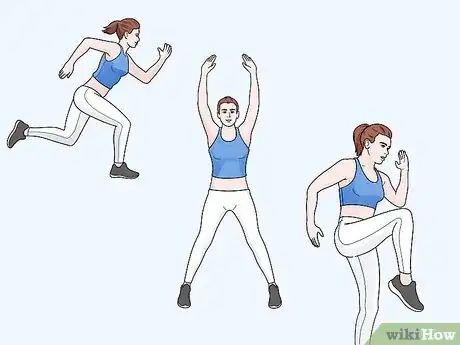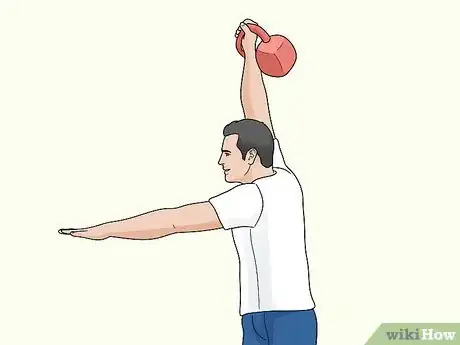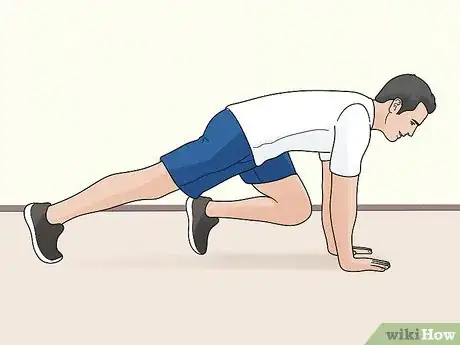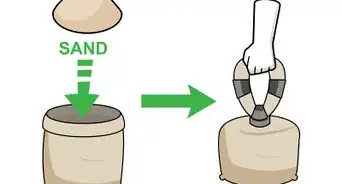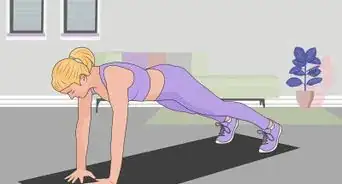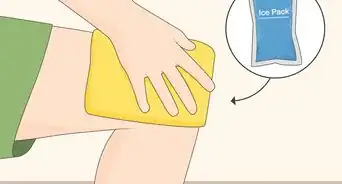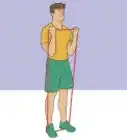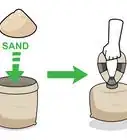This article was co-authored by Francisco Gomez and by wikiHow staff writer, Janice Tieperman. Francisco Gomez is the Head Coach at the FIT Potato Gym, a training gym established in 2001 in the San Francisco Bay Area. Francisco is a former competitive runner who helps endurance athletes train for major marathons like the Boston Marathon. Francisco specializes in Injury Rehab, Flexibility, Marathon Training, and Senior Fitness. He has a B.S. in Nutrition and Exercise Physiology & Running.
There are 11 references cited in this article, which can be found at the bottom of the page.
This article has been viewed 35,944 times.
High Intensity Interval Training (HIIT) is a popular workout style where you alternate periods of vigorous exercise with short breaks. Unlike more specific workouts, like Tabata, HIIT offers a lot of freedom and versatility, depending on fitness level.[1] Thankfully, HIIT doesn’t require any special equipment or instruction, and is easy to do from the comfort of your own home. After warming up, experiment with different workouts and see what works best for you!
Steps
Adding HIIT to Your Routine
-
1Warm up before you start exercising. Don’t jump straight into your HIIT workout—even if you’re exercising at home, give yourself some time to adjust before jumping into the circuit.
Start by doing 10-15 reps of leg swings, then work your way to side leg swings as well. To get your blood pumping, jump rope for a minute, then perform 10 reps of squats and 2 inchworms. If you don’t have a jump rope, do several reps of jumping jacks instead.[2]
You can tweak this warm-up as needed. Remember, the goal is to help you transition to your HIIT workout, but you don’t want to feel winded before you even begin! -
2Choose your favorite exercises for your HIIT routine. You can follow a pre-designed workout, or you can customize your workout. Pick out some exercises that you’re pretty skilled with, so you can push yourself to the limit as you exercise. There’s no right or wrong exercise—just pick activities where you can really push yourself, so you can get the most out of your HIIT workout.[3]
- For instance, jumping jacks, squats, push ups, and planks are all fair game for your workout.
- If you haven't worked out in a while, focus on exercises that will improve your flexibility, as well as less strenuous exercises like walking, riding a bike, or using a treadmill.[4]
Advertisement -
3Pick a workout format that balances vigorous exercise and rest. HIIT involves raising your heart rate quickly with short, intense bursts of exercise split up break periods.
Keep in mind that there’s no set time limit or requirement for these intervals, so you can choose a format that works best for you. Think about your current fitness levels and what your body can handle—there’s nothing wrong with building up to shorter rest periods as you develop more endurance.[5]
For instance, if you’re a beginner, you may want to exercise vigorously for 20 seconds, then rest with lighter exercise, like walking, for 2 minutes.[6]
If you’re a more seasoned athlete, you can try Tabata, a more intense form of HIIT. This involves 20 seconds of heavy exercise followed by 10 seconds of rest. -
4Time your workouts so they’re 20 minutes or less. Keep in mind that HIIT workouts are very intense, and are focused on getting your heart rate up. With this in mind, you shouldn’t be doing this kind of workout for longer than 20 minutes. If you’re a beginner, start out with a 4-5 minute circuit, then slowly work your way up in future workouts.[7]
- HIIT acts as a trade-off—while you don’t have to exercise as long, your workout will be much more strenuous than a normal, 30-60 minute workout.
- Since these workouts are short, you can fit them in almost any time. You can try doing them in the morning or evening, or fit a quick workout into your lunch break.[8]
-
5Push yourself to the limit during your exercise circuits. Try not to scale down the intensity of your exercises, even if you’re starting to get tired out. Do your best to put the max amount of effort into every portion of your workout. If you start to relax, you won’t reap benefits of a usual HIIT workout.[9]
- If you find yourself getting winded easily, limit yourself to a shorter circuit.
-
6Limit yourself to 3-4 HIIT workouts each week. While HIIT exercise is a great way to burn fat, don’t fit these workouts into your daily schedule. You don’t want to risk injuring or overworking yourself, which will cancel out all the positive effects of your workout. Alternate your HIIT sessions by at least 1 day so your body has time to heal and recover.[10]
- Even master athletes don’t do HIIT exercise every day!
-
7Cool down after you’ve finished your workout. Set aside a few minutes to stretch out your muscles before you call it quits. Start with a runner’s lunge, where 1 leg is bent forward, and the other leg is extended straight behind.
Additionally take some time to “release” certain parts of your body by rolling a tennis ball beneath your feet, hips, and glutes. To really stretch out your body, try the sleeping pigeon position, where you tuck 1 leg in front of your chest and extend the other straight behind.
Lean forward over your tucked foot with your arms outstretched for several minutes to get a good cool down.[11]
You can also try a dynamic lunge, where you pull and hold your back leg close to your glutes while your front leg is still bent forward.
Trying Simple Workouts
-
1Try out the P.A.U.L. method for a well-rounded workout. Note that the P.A.U.L. method stands for plyometric cardio, like jumping jacks; ab workouts, like crunches or blanks, upper body workouts, like push-ups, and lower body workouts, like lunges and squats.
Draft a list of different exercises that fit into these 4 categories, then string them together into a HIIT circuit. Do each workout for 30 seconds, and then give yourself 30 seconds to catch your breath. Continue this workout until you’ve exercised for 10 minutes.[12]
For instance, you can do jumping jacks for 30 seconds, crunches for 30 seconds, push-ups for 30 seconds, and then lunges for another 30 seconds. Once you finish this circuit, give yourself 30 seconds to rest. Monitor yourself with an interval timer so you remember when to switch activities and when to rest.
You can mix and match with whatever exercises you prefer! You don’t have to do a sequence of specific drills—what matters most is that you’re pushing yourself as you work out.
When you're doing a lunge, always be careful that your knee doesn't go past your toes. That will strain your knee, potentially leading to an injury, and it will make the exercise less effective in your quads and hips.[13] -
2Focus on strength training with a series of tough exercises. Perform several exercises in a row, doing at least 10 reps for each activity. Alternate between jumping jacks, squats, incline push-ups, planks, and a single-leg glute bridge, then give yourself 30 seconds to catch your breath. Repeat this circuit several times to complete your HIIT workout![14]
- For instance, you can do 20 jumping jacks, 10 squats, 10 seconds of inclined push-ups, a 30-second plank, and 5 reps for each leg with the glute bridge.
-
3Opt for a running-based HIIT workout if you prefer cardio. Run for 800 m (870 yd) as fast as you can, timing yourself as you go. Allot yourself that same amount of time to walk, so you can catch your breath. Do 4 sets of this circuit, then settle down with easy, 10-minute job.[15]
- You can warm-up your body by running for 10 minutes before you start.
Experimenting with Exercise Equipment
-
1Perform some kettlebell exercises to help you burn fat. Start by swinging the kettlebell for 30 seconds with 1 arm, switching arms after each swing. After this, hold the kettlebell securely in 1 hand and “jerk” it above your head before bringing it back below your shoulder.
Once the 15 seconds are up, grab the kettlebell and repeat the exercise with your opposite hand. To complete the circuit, clutch the kettlebell against your chest with both hands and squat for 30 seconds, keeping your back upright.[16]
Keep your knees bent and extended forward as you “jerk” the kettlebell upwards. Additionally, try to keep your heels planted on the ground to give yourself more support.[17]- Perform this workout multiple times, if you feel up to it!
-
2Alternate strength exercises with mountain climbers to get your blood pumping. Start with 1 minute of kettlebell swings, guiding the kettlebell from between your legs to the same level of your shoulders. Rest for 15 seconds, then do 30 seconds of mountain climbers before resting again.
After this, do some decline push-ups for 1 minute before resting again. Do another set of 30-second mountain climbers and give yourself a moment to rest. Finish off the circuit with 1 minute of fire hydrants, followed by another set of mountain climbers.
Fire hydrants are a strength-building exercise where you lay on your hands and knees. Lift your bent leg and extend it to the side, holding it in place for several seconds. Go back to your original position and do the same with your opposite leg.[18]- You can opt for shorter circuits, if that’s easier.
-
3Focus on cardio with a treadmill workout. Adjust your treadmill so you’re at a 5% incline, then raise the speed to 5 to 6 1⁄2 mph (8.0 to 10.5 km/h).
Run for 1 minute to get heart rate up, and then turn your treadmill speed down to 3 mph (4.8 km/h). Walk at this speed for 2 minutes before resetting back to the faster speed. Aim to do at least 6 repetitions of this exercise so you can get a full workout.[19]- It may help to go for an easy, 5-minute jog as a way to both warm up and cool down.
Expert Q&A
-
QuestionHow do you do a HIIT workout on a treadmill?
 Pete CerquaPete Cerqua is a Certified Personal Trainer and Nutritionist. Pete is also a five-time best-selling author of books including "The 90-Second Fitness Solution" and "High Intensity Fitness Revolution for Women/Men" published by Simon and Schuster and Skyhorse Publishing. Pete has over 20 years of personal training and nutrition coaching experience and operates the 90-Second Fitness flagship studio in New York City.
Pete CerquaPete Cerqua is a Certified Personal Trainer and Nutritionist. Pete is also a five-time best-selling author of books including "The 90-Second Fitness Solution" and "High Intensity Fitness Revolution for Women/Men" published by Simon and Schuster and Skyhorse Publishing. Pete has over 20 years of personal training and nutrition coaching experience and operates the 90-Second Fitness flagship studio in New York City.
Certified Personal Trainer & Nutritionist You can use what is known as the Tabata method. On the treadmill, you could sprint for 20 seconds or longer, then do a light jog or walk for half as long as you sprinted. Repeat this until you've done the cycle 8 times.
You can use what is known as the Tabata method. On the treadmill, you could sprint for 20 seconds or longer, then do a light jog or walk for half as long as you sprinted. Repeat this until you've done the cycle 8 times. -
QuestionWhere do I start if I'm really out of shape?
 Francisco GomezFrancisco Gomez is the Head Coach at the FIT Potato Gym, a training gym established in 2001 in the San Francisco Bay Area. Francisco is a former competitive runner who helps endurance athletes train for major marathons like the Boston Marathon. Francisco specializes in Injury Rehab, Flexibility, Marathon Training, and Senior Fitness. He has a B.S. in Nutrition and Exercise Physiology & Running.
Francisco GomezFrancisco Gomez is the Head Coach at the FIT Potato Gym, a training gym established in 2001 in the San Francisco Bay Area. Francisco is a former competitive runner who helps endurance athletes train for major marathons like the Boston Marathon. Francisco specializes in Injury Rehab, Flexibility, Marathon Training, and Senior Fitness. He has a B.S. in Nutrition and Exercise Physiology & Running.
Fitness Coach If you haven't exercised in a while, you should probably start out by doing flexibility exercises. You might also do things like walking, using a treadmill, or riding a bike for 2-4 weeks before you jump into actual strength exercises.
If you haven't exercised in a while, you should probably start out by doing flexibility exercises. You might also do things like walking, using a treadmill, or riding a bike for 2-4 weeks before you jump into actual strength exercises.
Warnings
- Don’t overwork yourself! If you’re new to HIIT, start with smaller workouts so you can build your endurance. You can always lengthen your workouts as you get more experienced!⧼thumbs_response⧽
Things You’ll Need
- Kettlebell (optional)
References
- ↑ https://www.unm.edu/~lkravitz/Article%20folder/HIITvsCardio.html
- ↑ https://www.12minuteathlete.com/pre-hiit-workout-warm-up/
- ↑ https://www.insider.com/hiit-workouts-you-can-do-at-home-2018-7
- ↑ Francisco Gomez. Fitness Coach. Expert Interview. 24 October 2019.
- ↑ https://www.insider.com/hiit-workouts-you-can-do-at-home-2018-7
- ↑ https://www.coachmag.co.uk/cardio-workouts/6419/how-to-get-hiit-workouts-right-because-they-re-easy-to-get-wrong
- ↑ https://www.insider.com/hiit-workouts-you-can-do-at-home-2018-7
- ↑ https://myy.org/top-5-benefits-of-hiit-workouts/
- ↑ https://www.insider.com/what-is-hiit-2018-2#you-do-hiit-too-often-6
- ↑ https://www.insider.com/what-is-hiit-2018-2
- ↑ https://dailyburn.com/life/fitness/post-hiit-workout-stretches/
- ↑ https://www.insider.com/hiit-workouts-you-can-do-at-home-2018-7
- ↑ Francisco Gomez. Fitness Coach. Expert Interview. 24 October 2019.
- ↑ https://www.insider.com/hiit-workouts-you-can-do-at-home-2018-7
- ↑ https://www.unm.edu/~lkravitz/Article%20folder/HIITvsCardio.html
- ↑ https://www.coachmag.co.uk/cardio-workouts/6419/how-to-get-hiit-workouts-right-because-they-re-easy-to-get-wrong
- ↑ https://m.youtube.com/watch?v=DGql83eyHRE&t=1m30s
- ↑ https://www.mensjournal.com/health-fitness/at-home-hiit-workouts-to-get-fit-fast/
- ↑ https://www.unm.edu/~lkravitz/Article%20folder/HIITvsCardio.html
- ↑ https://www.insider.com/hiit-workouts-you-can-do-at-home-2018-7
- ↑ https://www.coachmag.co.uk/cardio-workouts/6419/how-to-get-hiit-workouts-right-because-they-re-easy-to-get-wrong
- ↑ Francisco Gomez. Fitness Coach. Expert Interview. 24 October 2019.






